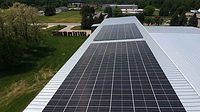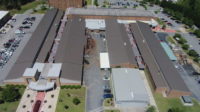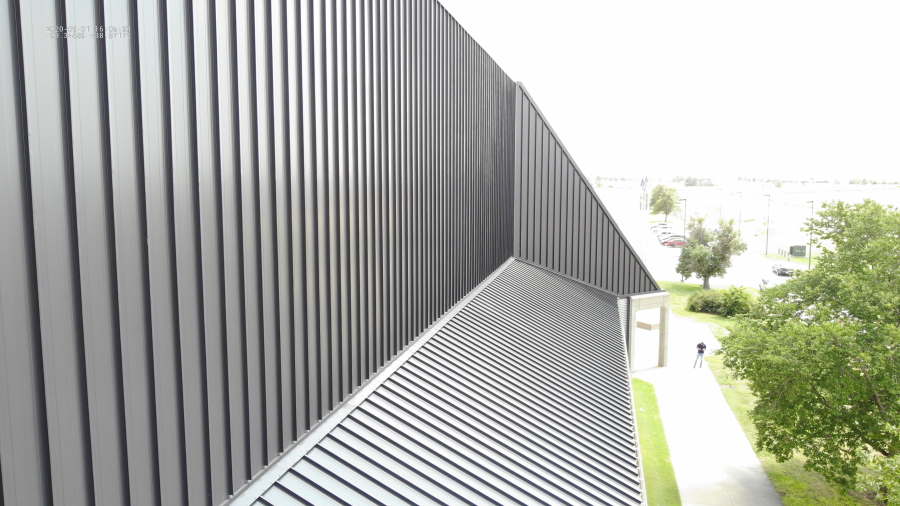Project Profile: McElroy Metal’s 238T Symmetrical Panel Recovers Coliseum Roof, Wall

Approximately 50,000 square feet of McElroy Metal’s 238T symmetrical standing seam panels were installed as the replacement roof for the Gross Memorial Coliseum at Fort Hays State University. Photos courtesy of McElroy Metal.

“We’ve installed this system on many roofs, but this was the first as a large vertical wall,” said Luke Haines, president of Roofmasters. “It’s an exceptional watertight system, so it can be installed as a wall.”

The owner wanted to keep the look of the standing seam roof and the color. Metal was the only option as a replacement and to keep the same look, Dark Bronze was chosen as the color.



BOSSIER CITY, La. — The usually busy Fort Hays State University campus was closer to a ghost town when the COVID-19 pandemic hit in March. Students were attending classes online and athletic events were canceled. It turned out to be the perfect time to reroof — and re-wall — Gross Memorial Coliseum.
After 50 years of enduring heavy winds, hailstorms and whatever Mother Nature could throw at it, an aging copper batten roof was leaking in spots and had to be removed by Roofmasters of Hays, Kan. Approximately 50,000 square feet of McElroy Metal’s 238T symmetrical standing seam panels were installed as the replacement roof.
“Everyone was used to the way that roof looked,” said Kelly McMurphy, AIA, partner at Landmark Architects of Hutchinson, Kan. “The owner wanted to keep the look of the standing seam roof and the color. Metal was the only option as a replacement and to keep the same look, Dark Bronze was chosen as the color.”
McMurphy said the roof is very visible from the nearby highway and everyone wanted to be sure it would look good and last for decades.
“Working with Roofmasters and (McElroy Metal National Recover Manager) Charlie Smith, I felt we had all our bases covered,” McMurphy said. “Roofmasters has installed a lot of standing seam roofing. I knew this roof would be detailed better and installed better than the original roof. I couldn’t be more pleased with how it all turned out.”
Luke Haines, president and owner of Roofmasters, says the 2-inch by 2-inch redwood battens the copper panels were attached with had disintegrated from being subjected to years of extreme heat under the copper caps. His crew removed the battens and some of the roof deck then covered the entire roof with a self-adhering high-temperature ice and water shield. Roofmasters installed 50,000 square feet of McElroy Metal’s 238T symmetrical standing seam panels — most as roofing, but some as walls. Dark Bronze resembles the original copper roof when it reached its 50-year-old patina.
“We’ve installed this system on many roofs, but this was the first as a large vertical wall,” Haines said. “It’s an exceptional watertight system, so it can be installed as a wall.”
The vertical “walls” are between the four steep-slope (14:12) entrances around the building. At the bottom of the metal panel walls is a lower slope roof (8:12). Roofmasters hoisted a roll former to the upper low slope roof deck of the coliseum and the panels for the steep slope and the 20-foot vertical walls were produced there. Each panel, up to 65 feet long, was lowered by hand from the flat roofing section into place with a rope and clamp.
“Where the wall panels meet the lower slope roofing sections, there were some serious leaking problems there,” Haines said. “The original copper panels were not continuous panels; they were only 8 feet long and they were folded at the bottom of the wall where it meets the lower sloped roofing. Years of expanding and contracting left some gaps. With the new roof, we were able to work up a detail to avoid that problem. The wall panels are pinned at the top, so they can move at the bottom. Customized proper flashing at the transition of the vertical to steep slope was installed and stripped in with high-temp ice-and-water underlayment. We were careful to design and implement redundancy in the details as the roof and wall project will be here for years in the future."
Another challenging detail was the internal gutter at the bottom of the steep-sloped roofing above the entrances. Haines says the PVC-coated metal was heat-welded with strips at the laps to make it watertight. The gutters are more than a foot wide. The details were important from the design to the installation and Roofmasters workmen were a key component for a timely quality finish.
Gross Memorial Coliseum, constructed in 1973 with a capacity of 6,814, was named a Top 5 Arena in NCAA Division II by Hero Sports and to the Best Division II Arenas list by the NCAA in 2018. It was voted the Best Arena in Division II by T3Bracketology Twitter Arena Bracket Challenge in 2020.
Looking for a reprint of this article?
From high-res PDFs to custom plaques, order your copy today!








